Page 2372 of 5135

160MD±01
A79169
Water Drain
Plug
Radiator Drain Plug
A63951
A
B 16±44
± COOLINGENGINE COOLANT (1CD±FTV)
AVENSIS REPAIR MANUAL (RM1018E)
ENGINE COOLANT (1CD±FTV)
REPLACEMENT
1. DRAIN ENGINE COOLANT
(a) Remove the radiator cap.
(b) Loosen the radiator and engine drain plugs, drain the
coolant.
(c) Close the drain plugs.
Torque: 13 N�m (133 kgf�cm, 10 ft�lbf) for engine
2. ADD ENGINE COOLANT
(a) Loosen air bleed valve A.
(b) Fill the cooling system with coolant up to line B.
Capacity:
With heater: 7.6 liters (8.0 US qts, 6.7 lmp. qts)
Without heater: 7.4 liters (7.8 US qts, 6.5 lmp. qts)
HINT:
�Use of improper coolants may damage engine cooling
system.
�Use ºToyota Long Life Coolantº or equivalent and mix it
with plain water according to the manufacturer's instruc-
tion.
�Using of coolant which includes more than 50 % (freezing
protection down to ±35�C (±31�F)) or 60 % (freezing
protection down to ±50�C (±58�F)) of ethylene±glycol is
recommended but not more than 70 %.
(c) Tighten the air bleed valve securely.
(d) Install the radiator cap securely.
(e) Warm up the engine.
HINT:
Warm up the engine with the speed of 2,000 rpm or more and
keep the warm±up until the thermostat has open and the radia-
tor reservoir has become hot.
(f) Run the engine intermittently for 5 seconds at 3,000 rpm
and for 45 seconds at idle.
(g) Do the above operation for 7 minutes or more.
(h) After the engine has become cold, check that the coolant
level is between LOW and FULL lines.
Page 2373 of 5135
± COOLINGENGINE COOLANT (1CD±FTV)
16±45
AVENSIS REPAIR MANUAL (RM1018E)
3. CHECK FOR ENGINE COOLANT LEAKS
(a) Fill the radiator with coolant and attach a radiator cap tester.
(b) Pump it to 137 kPa (1.4 kgf/cm
2,
19.9 psi), and check that the pressure does not drop.
Page 2377 of 5135
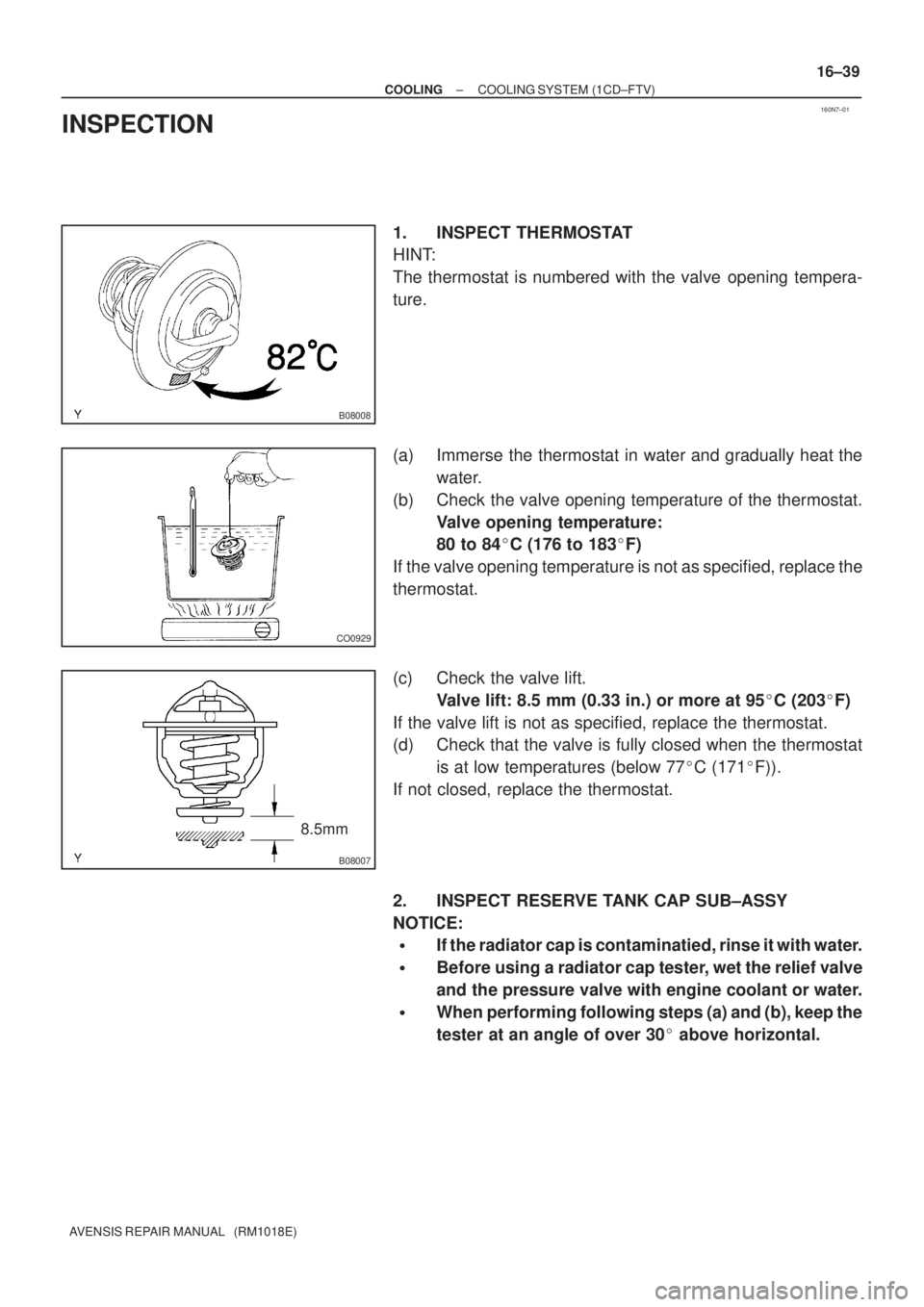
160N7±01
B08008
CO0929
B08007
8.5mm
± COOLINGCOOLING SYSTEM (1CD±FTV)
16±39
AVENSIS REPAIR MANUAL (RM1018E)
INSPECTION
1. INSPECT THERMOSTAT
HINT:
The thermostat is numbered with the valve opening tempera-
ture.
(a) Immerse the thermostat in water and gradually heat the
water.
(b) Check the valve opening temperature of the thermostat.
Valve opening temperature:
80 to 84�C (176 to 183�F)
If the valve opening temperature is not as specified, replace the
thermostat.
(c) Check the valve lift.
Valve lift: 8.5 mm (0.33 in.) or more at 95�C (203�F)
If the valve lift is not as specified, replace the thermostat.
(d) Check that the valve is fully closed when the thermostat
is at low temperatures (below 77�C (171�F)).
If not closed, replace the thermostat.
2. INSPECT RESERVE TANK CAP SUB±ASSY
NOTICE:
�If the radiator cap is contaminatied, rinse it with water.
�Before using a radiator cap tester, wet the relief valve
and the pressure valve with engine coolant or water.
�When performing following steps (a) and (b), keep the
tester at an angle of over 30� above horizontal.
Page 2378 of 5135
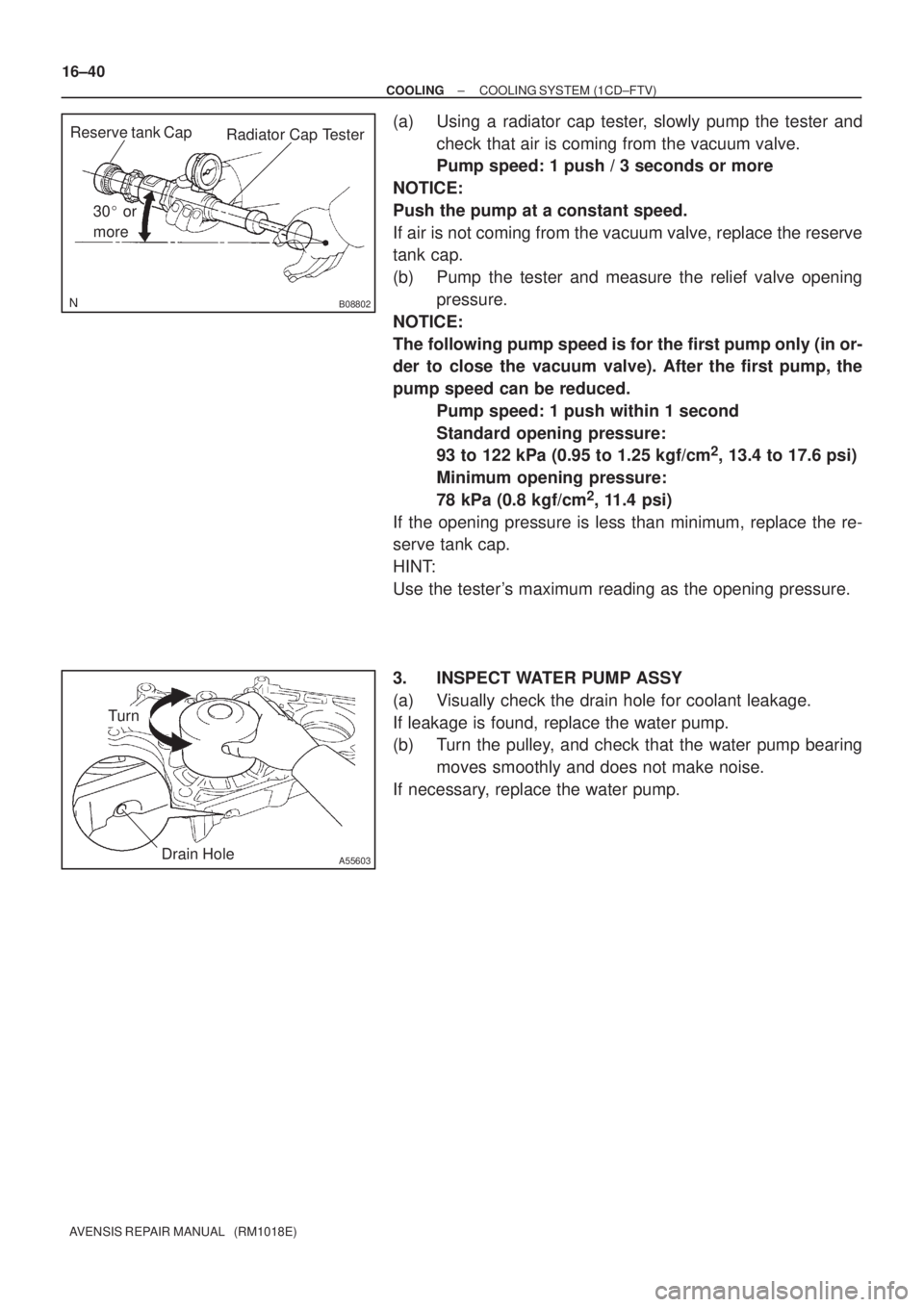
B08802
Radiator Cap Tester
30� or
more Reserve tank Cap
A55603Drain Hole
Turn
16±40
± COOLINGCOOLING SYSTEM (1CD±FTV)
AVENSIS REPAIR MANUAL (RM1018E)
(a) Using a radiator cap tester, slowly pump the tester and
check that air is coming from the vacuum valve.
Pump speed: 1 push / 3 seconds or more
NOTICE:
Push the pump at a constant speed.
If air is not coming from the vacuum valve, replace the reserve
tank cap.
(b) Pump the tester and measure the relief valve opening
pressure.
NOTICE:
The following pump speed is for the first pump only (in or-
der to close the vacuum valve). After the first pump, the
pump speed can be reduced.
Pump speed: 1 push within 1 second
Standard opening pressure:
93 to 122 kPa (0.95 to 1.25 kgf/cm
2, 13.4 to 17.6 psi)
Minimum opening pressure:
78 kPa (0.8 kgf/cm
2, 11.4 psi)
If the opening pressure is less than minimum, replace the re-
serve tank cap.
HINT:
Use the tester's maximum reading as the opening pressure.
3. INSPECT WATER PUMP ASSY
(a) Visually check the drain hole for coolant leakage.
If leakage is found, replace the water pump.
(b) Turn the pulley, and check that the water pump bearing
moves smoothly and does not make noise.
If necessary, replace the water pump.
Page 2379 of 5135
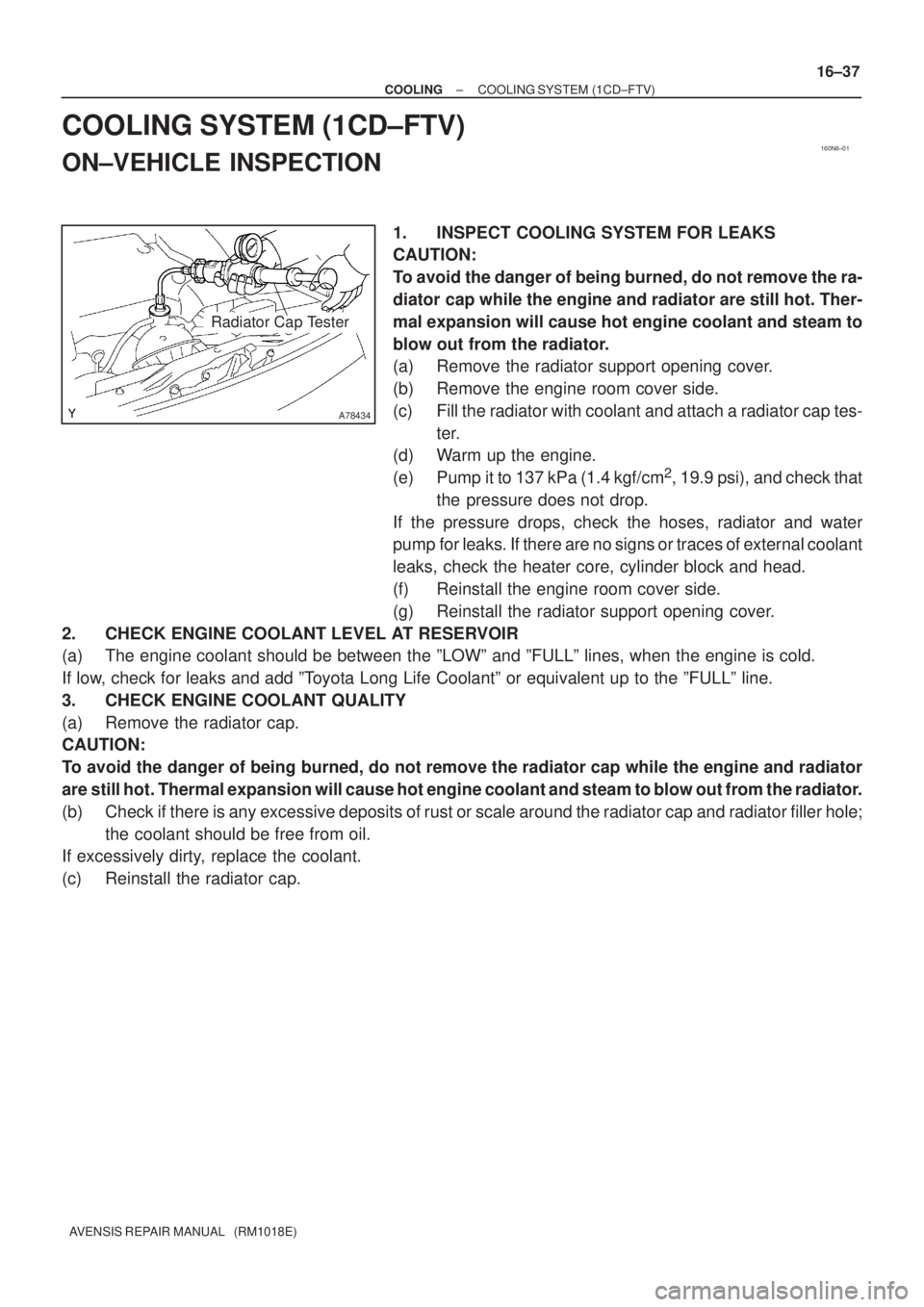
160N6±01
A78434
Radiator Cap Tester
± COOLINGCOOLING SYSTEM (1CD±FTV)
16±37
AVENSIS REPAIR MANUAL (RM1018E)
COOLING SYSTEM (1CD±FTV)
ON±VEHICLE INSPECTION
1. INSPECT COOLING SYSTEM FOR LEAKS
CAUTION:
To avoid the danger of being burned, do not remove the ra-
diator cap while the engine and radiator are still hot. Ther-
mal expansion will cause hot engine coolant and steam to
blow out from the radiator.
(a) Remove the radiator support opening cover.
(b) Remove the engine room cover side.
(c) Fill the radiator with coolant and attach a radiator cap tes-
ter.
(d) Warm up the engine.
(e) Pump it to 137 kPa (1.4 kgf/cm
2, 19.9 psi), and check that
the pressure does not drop.
If the pressure drops, check the hoses, radiator and water
pump for leaks. If there are no signs or traces of external coolant
leaks, check the heater core, cylinder block and head.
(f) Reinstall the engine room cover side.
(g) Reinstall the radiator support opening cover.
2. CHECK ENGINE COOLANT LEVEL AT RESERVOIR
(a) The engine coolant should be between the ºLOWº and ºFULLº lines, when the engine is cold.
If low, check for leaks and add ºToyota Long Life Coolantº or equivalent up to the ºFULLº line.
3. CHECK ENGINE COOLANT QUALITY
(a) Remove the radiator cap.
CAUTION:
To avoid the danger of being burned, do not remove the radiator cap while the engine and radiator
are still hot. Thermal expansion will cause hot engine coolant and steam to blow out from the radiator.
(b) Check if there is any excessive deposits of rust or scale around the radiator cap and radiator filler hole;
the coolant should be free from oil.
If excessively dirty, replace the coolant.
(c) Reinstall the radiator cap.
Page 2385 of 5135
160MU±01
A77341
Radiator Drain Cock Plug Radiator Cap
Cylinder Bllock Drain Cock Plug
Drain Pipe
± COOLINGENGINE COOLANT (1AZ±FSE)
16±31
AVENSIS REPAIR MANUAL (RM1018E)
ENGINE COOLANT (1AZ±FSE)
REPLACEMENT
1. DRAIN ENGINE COOLANT
CAUTION:
To avoid the danger of being burned, do not remove the ra-
diator cap while the engine and radiator are still hot, as fluid
and steam can be blown out under pressure.
(a) Remove the radiator cap.
(b) Loosen the radiator plug and drain the coolant.
Page 2386 of 5135
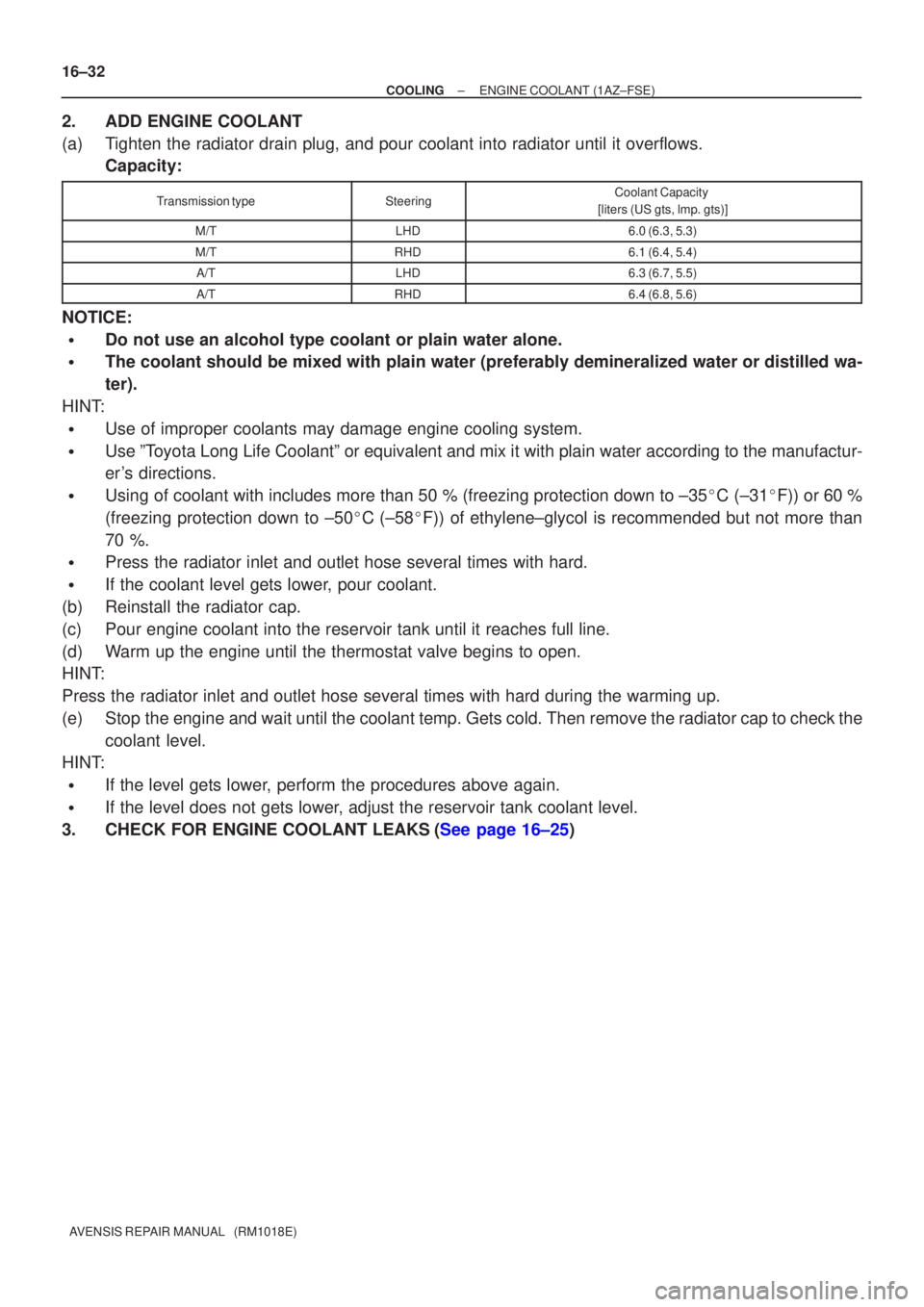
16±32
±
COOLING ENGINE COOLANT(1AZ±FSE)
AVENSIS REPAIR MANUAL (RM1018E)
2.ADD ENGINE COOLANT
(a)Tighten the radiator drain plug, and pour coolant into radiator until it \
overflows. Capacity:
Transmission typeSteeringCoolant Capacity
[liters (US gts, lmp. gts)]
M/TLHD6.0 (6.3, 5.3)
M/TRHD6.1 (6.4, 5.4)
A/TLHD6.3 (6.7, 5.5)
A/TRHD6.4 (6.8, 5.6)
NOTICE:
�Do not use an alcohol type coolant or plain water alone.
�The coolant should be mixed with plain water (preferably demineralized wat\
er or distilled wa-
ter).
HINT:
�Use of improper coolants may damage engine cooling system.
�Use ºToyota Long Life Coolantº or equivalent and mix it with plain water ac\
cording to the manufactur-
er's directions.
�Using of coolant with includes more than 50 % (freezing protection down to ±\
35 �C (±31 �F)) or 60 %
(freezing protection down to ±50 �C (±58 �F)) of ethylene±glycol is recommended but not more than
70 %.
�Press the radiator inlet and outlet hose several times with hard.
�If the coolant level gets lower, pour coolant.
(b)Reinstall the radiator cap.
(c)Pour engine coolant into the reservoir tank until it reaches full line.
(d)Warm up the engine until the thermostat valve begins to open.
HINT:
Press the radiator inlet and outlet hose several times with hard during \
the warming up.
(e)Stop the engine and wait until the coolant temp. Gets cold. Then remove the radiator cap to check the coolant level.
HINT:
�If the level gets lower, perform the procedures above again.
�If the level does not gets lower, adjust the reservoir tank coolant level.
3.CHECK FOR ENGINE COOLANT LEAKS(See page 16±25)
Page 2389 of 5135
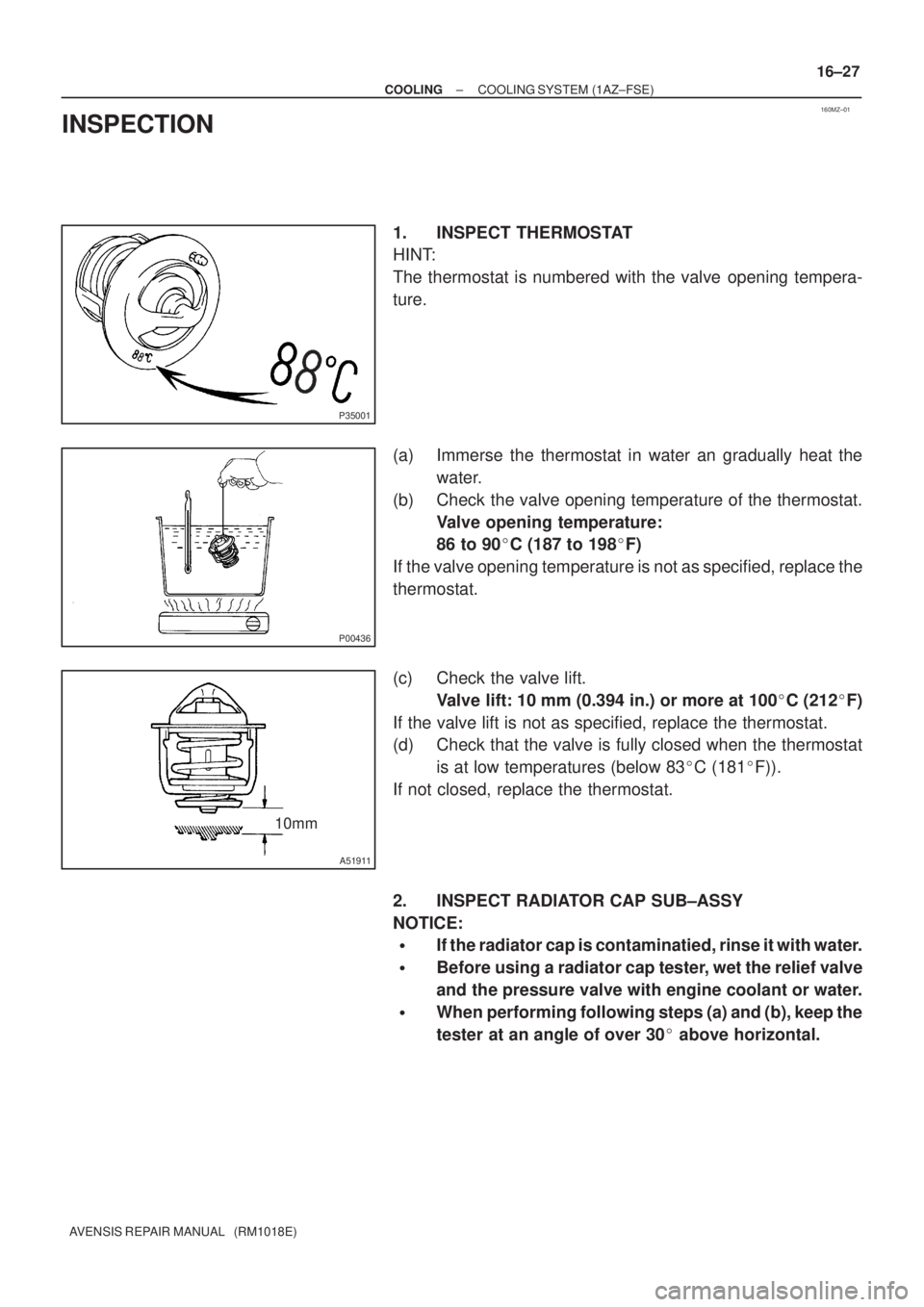
160MZ±01
P35001
P00436
10mm
A51911
± COOLINGCOOLING SYSTEM (1AZ±FSE)
16±27
AVENSIS REPAIR MANUAL (RM1018E)
INSPECTION
1. INSPECT THERMOSTAT
HINT:
The thermostat is numbered with the valve opening tempera-
ture.
(a) Immerse the thermostat in water an gradually heat the
water.
(b) Check the valve opening temperature of the thermostat.
Valve opening temperature:
86 to 90�C (187 to 198�F)
If the valve opening temperature is not as specified, replace the
thermostat.
(c) Check the valve lift.
Valve lift: 10 mm (0.394 in.) or more at 100�C (212�F)
If the valve lift is not as specified, replace the thermostat.
(d) Check that the valve is fully closed when the thermostat
is at low temperatures (below 83�C (181�F)).
If not closed, replace the thermostat.
2. INSPECT RADIATOR CAP SUB±ASSY
NOTICE:
�If the radiator cap is contaminatied, rinse it with water.
�Before using a radiator cap tester, wet the relief valve
and the pressure valve with engine coolant or water.
�When performing following steps (a) and (b), keep the
tester at an angle of over 30� above horizontal.